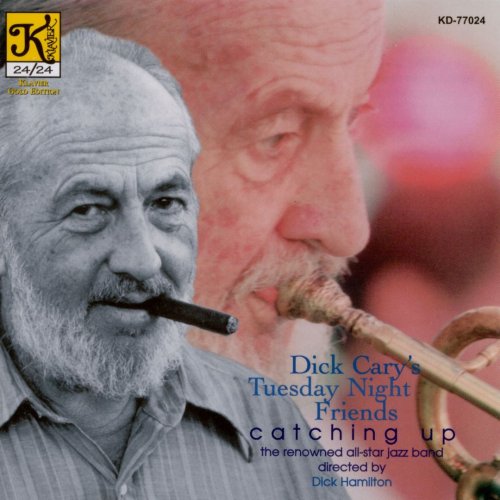
Dick Cary's Tuesday Night Friends - Catching Up (1999)
BAND/ARTIST: Dick Cary's Tuesday Night Friends
- Title: Catching Up
- Year Of Release: 1999
- Label: Klavier
- Genre: Jazz
- Quality: Mp3 / 320kbps
- Total Time: 69:26 min
- Total Size: 156 MB
- WebSite: Album Preview
Tracklist
------------
01. Catching Up
02. Oofy
03. September Etude
04. The Albatross
05. Late Sunday
06. Gramercy Park
07. Shim-Me-Sha Wobble Shim-Me-Sha-Wabble
08. Black And Blue
09. Between Prone And Supine
10. December Song
11. Rialto
12. Sea Of Cortez
13. B-E-T-T-Y O'-H-A-R-A
14. Recado
15. White April
16. Sgt. Pee Wee
------------
01. Catching Up
02. Oofy
03. September Etude
04. The Albatross
05. Late Sunday
06. Gramercy Park
07. Shim-Me-Sha Wobble Shim-Me-Sha-Wabble
08. Black And Blue
09. Between Prone And Supine
10. December Song
11. Rialto
12. Sea Of Cortez
13. B-E-T-T-Y O'-H-A-R-A
14. Recado
15. White April
16. Sgt. Pee Wee
Alto Saxophone – Dick Hamilton; Baritone Saxophone – Betty O'Hara, Fred Cooper, Randy Aldcroft, Tommy Newsome; Bass – Herb Mickman; Clarinet – Abe Most, John Bambridge, Tommy Newsome; Drums – Jerry White; Euphonium – Betty O'Hara; Guitar – Dave Koonse; Leader – Dick Hamilton; Piano – Dick Hamilton; Soprano Saxophone – Tommy Newsome; Tenor Saxophone – John Bambridge, Terry Harrington; Trombone – Betty O'Hara, Ernie Tack; Trumpet – Dick Hamilton, Jack Trott.
Dick Cary’s friends are keeping alive his astonishing output of undated, unclassifiable compositions and arrangements. Cary’s most visible musical roles were as pianist, trumpeter, mellophonist and alto horn operator in bands playing Dixieland. The term Dixieland rankled him but he was stuck with it because of his associations. In the early 1940s Cary was house pianist at Nick’s traditional jazz emporium in Greenwich Village. His highlights as a player came with Louis Armstrong’s original All-Stars and in a productive association with Bobby Hackett in the 1950s. Throughout his career he also worked as an arranger, for Benny Goodman, Jimmy Dorsey, Glen Gray, Hackett and his own bands, among others.
For his last couple of decades Cary, who died in 1994, held sessions once a week at his house which were populated by Los Angeles studio musicians eager to play his intriguing, unconventional charts. This album has some of those friends playing 16 of his pieces. The music is full of rich textures, unexpected rhythmic displacements, written lines that sound improvised, pungent 20th century classical harmonies, exuberance, wryness, subtlety and nothing that sounds like Dixieland. Most of the pieces are Cary’s, but when he tackled a standard like “Black and Blue” he transformed it. Cary’s arrangements inspire fine solos from the ensemblists, especially clarinetist Abe Most, tenor saxophonist Tommy Newsom and the late trombonist Betty O’Hara. Newsom, a focused and consistently interesting soloist, radiates the spirit of Al Cohn and Zoot Sims. Dick Hamilton, who leads the group, is impressive on piano, trumpet and the alto horn he inherited from Cary. ~Doug Ramsey
Dick Cary’s friends are keeping alive his astonishing output of undated, unclassifiable compositions and arrangements. Cary’s most visible musical roles were as pianist, trumpeter, mellophonist and alto horn operator in bands playing Dixieland. The term Dixieland rankled him but he was stuck with it because of his associations. In the early 1940s Cary was house pianist at Nick’s traditional jazz emporium in Greenwich Village. His highlights as a player came with Louis Armstrong’s original All-Stars and in a productive association with Bobby Hackett in the 1950s. Throughout his career he also worked as an arranger, for Benny Goodman, Jimmy Dorsey, Glen Gray, Hackett and his own bands, among others.
For his last couple of decades Cary, who died in 1994, held sessions once a week at his house which were populated by Los Angeles studio musicians eager to play his intriguing, unconventional charts. This album has some of those friends playing 16 of his pieces. The music is full of rich textures, unexpected rhythmic displacements, written lines that sound improvised, pungent 20th century classical harmonies, exuberance, wryness, subtlety and nothing that sounds like Dixieland. Most of the pieces are Cary’s, but when he tackled a standard like “Black and Blue” he transformed it. Cary’s arrangements inspire fine solos from the ensemblists, especially clarinetist Abe Most, tenor saxophonist Tommy Newsom and the late trombonist Betty O’Hara. Newsom, a focused and consistently interesting soloist, radiates the spirit of Al Cohn and Zoot Sims. Dick Hamilton, who leads the group, is impressive on piano, trumpet and the alto horn he inherited from Cary. ~Doug Ramsey
IsraCloud : Download
As a ISRA.CLOUD's PREMIUM member you will have the following benefits:
- Unlimited high speed downloads
- Download directly without waiting time
- Unlimited parallel downloads
- Support for download accelerators
- No advertising
- Resume broken downloads


